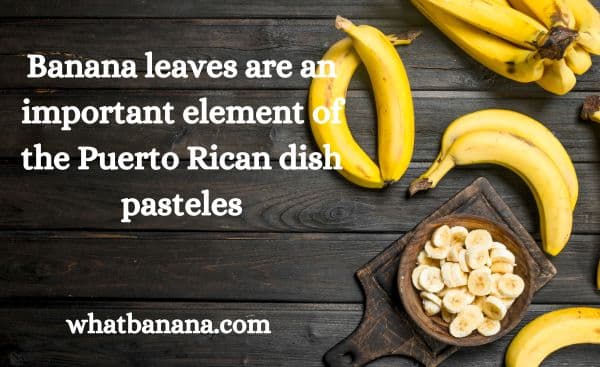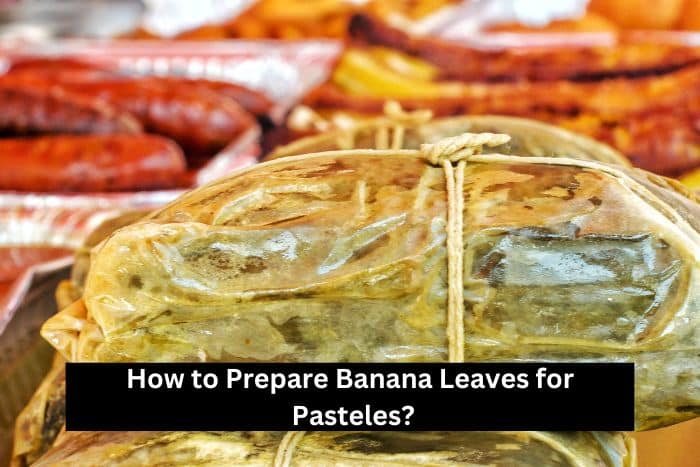I don’t know about you, but I love to explore different flavors and new cuisines.
It’s a bit like going on a culinary adventure!
I have recently discovered the delights of Puerto Rican cuisine, especially pasteles, one of their traditional dishes.
It’s quite a complicated recipe, as the dough is made from plantains or yucca, and then it’s stuffed with pork or chicken.
But the task that seems to cause the most problems is preparing the banana leaves that the pasteles are wrapped in!
Let’s see if there are any useful tips and tricks to help!
Embrace the Culture: Perfecting the Technique of Banana Leaf Wrapping for Pasteles
Banana leaves are an important element of the Puerto Rican dish pasteles. To prepare the leaves, the first step is to rinse them under cold water. Carefully cut away any brown spots. The banana leaves need to be soft and pliable, and this can be achieved by lightly charring them over a flame. Allow the leaves to cool before cutting them into 10- to 12-inch squares. Finally, wipe the banana leaves with a damp cloth. They can now be used to wrap the pasteles, adding a traditional, authentic flavor to the dish.
How Do You Select the Perfect Banana Leaves for Pasteles?
This is a step you need to pay attention to, or it can make or break your dish!
Selecting the best banana leaves for your pasteles is essential.
Ideally, you need to choose the freshest leaves possible, with no rips or tears.
And avoid those with any obvious blemishes.
The banana leaves should be a vivid green color, not yellow or brown.
If they are discolored, they are too mature and will be challenging to work with.
The leaves should have a smooth texture and, of course, be large enough to wrap your delicious pasteles!
Remember that the banana leaves will also add flavor to your dish; they should have a sweet aroma.
The odor should be mild, not too strong, or it will overpower the filling.
Surprisingly, not all leaves smell the same; it depends on where they were grown.
So, take a good sniff at them if they are not pre-packaged!
Hopefully, you should be able to find banana leaves in your local store, but you may need to find a specialty grocery shop.
| Rank | Dish Name | Description |
|---|---|---|
| 1 | Mofongo | Fall in love with this heavenly blend of fried green plantains, mashed to perfection, and mixed with garlic, olive oil, and crispy pork cracklings. A true taste of Puerto Rico! |
| 2 | Arroz con Gandules | Savor the warm embrace of this iconic dish, made with rice, pigeon peas, and an exquisite blend of spices. Arroz con Gandules is the heart of every Puerto Rican celebration! |
| 3 | Lechón Asado | Indulge in the mouthwatering flavors of succulent, slow-roasted pork marinated in a blend of spices and cooked over an open flame. The ultimate Puerto Rican feast! |
| 4 | Pastelón | Experience the sweet and savory symphony of Pastelón, a tantalizing casserole made from layers of sweet plantains, seasoned ground beef, and melted cheese. Pure comfort! |
| 5 | Alcapurrias | Delight your taste buds with Alcapurrias, irresistible fritters made from green bananas and yautía dough, filled with savory meat or seafood. A crispy, golden masterpiece! |
What is the Best Way to Clean Banana Leaves for Pasteles?
The last thing you want is some unexpected taste or texture in your recipe, so you need to clean the banana leaves properly.
It’s not a task that can be rushed!
The first step is to rinse the banana leaves under cold water, removing any obvious debris or dirt.
Wipe them down with a damp cloth, and check there is no sap on the leaves.
If they are really dirty, you can use mild soap and warm water, but they will need to be rinsed thoroughly so as not to leave any soap residue.
The banana leaves add flavor to the dish, so any dirt or sap will change the taste of the pasteles, and not for the better!
Dirt could also add a gritty texture, which won’t be pleasant.
And, of course, you want the paste to look visually appealing!

How Do You Soften and Cut Banana Leaves for Pasteles?
This for me is the trickiest bit, softening the leaves, and it took me a while before I got it right.
And they need to be cut to the right size to make that perfect, tasty parcel.
There are two ways that you can soften banana leaves, so it depends on what equipment you have.
Firstly, you can char them over an open flame.
They will turn a darker green, and you will physically feel them becoming more pliable.
The second method is to steam them, which, to me, seems a lot safer!
Once softened, you need to cut the banana leaves to an appropriate size.
You can either use a sharp knife or scissors and theoretically, they should be 10 to 12 inches square.
At this stage, you should also cut away any thick veins or stalks, as they will make the leaves difficult to fold.
You need to ensure the leaves will wrap securely around the filing and have no rips or tears.
If you wish, you can prepare the leaves in advance and store them in your refrigerator for up to a week.
You can freeze them too, but make sure they are tightly wrapped in aluminum foil or plastic to stop them from drying out.
Wrapping Puerto Rican Pasteles
Key Takeaways
- To choose the perfect banana leaves for pasteles, look for those that are fresh, free of rips, tears, or blemishes, and have a sweet, mild aroma
- Cleaning the banana leaves properly is essential to avoid any unwanted textures or flavors in your pasteles
- To soften the banana leaves for pasteles, steam them or hold them over an open flame for several minutes until they become pliable
- You can store banana leaves in your refrigerator for up to a week or freeze them for later
- By following these tips, you can prepare banana leaves for pasteles like a professional chef and add an authentic touch
I hope this helped and that you are now more confident in preparing your banana leaves!
Are you ready to try making pasteles with freshly prepared banana leaves?
You might also be interested in learning why banana leaves sometimes split.
